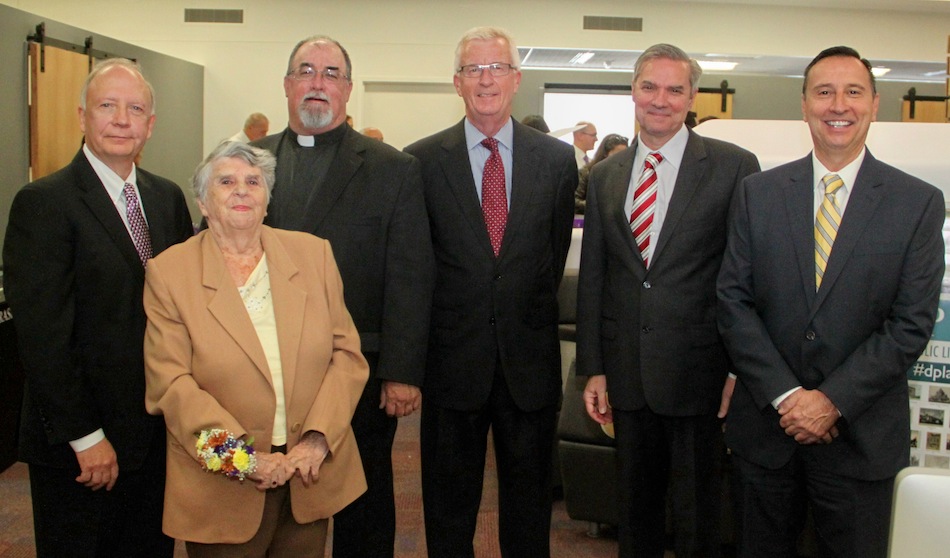Reilly Learning Commons Opens in Library
The learning commons was named in honor of Joe, Katherine “Kay” ’53 and Evelyn Reilly ’52. At the ceremony, Kay Reilly officially opens the Reilly Learning Commons on the first floor of the Weinberg Memorial Library, assisted by Michelle McHugh, learning commons coordinator and assistant professor, library, at The University of Scranton.

Weinberg Memorial Library held a Ribbon Cutting Ceremony to celebrate the official opening of the Reilly Learning Commons, a redesigned area on the first floor of the library that includes state-of-the-art computers, collaboration spaces, a lecture capture room and satellite locations for the Writing Center and Technology Support Center. From left are, Charles Kratz, dean of the library and information fluency; Katherine “Kay” Reilly of The University of Scranton’s class of 1953; Richard Malloy, S.J., executive director of campus ministries; Gary Olsen, vice president for University advancement; Donald Boomgaarden, Ph.D., provost and senior vice president for academic affairs; and Scranton Mayor Bill Courtright.
The Weinberg Memorial Library just got loud, and the librarians aren’t even complaining.
A Ribbon Cutting Ceremony to celebrate the official opening of the Reilly Learning Commons took place Sept. 17. The completely redesigned first-floor area of the Weinberg Memorial Library features state-of-the-art computers including Macs and PCs, a soundproof lecture capture room and collaboration spaces outfitted with outlets and ports for the easy integration of laptops and tablets, as well as satellite locations for the Writing Center and Technology Support Center.
“We wanted to create a new, dynamic student-centered learning space,” said Charles Kratz, dean of the library and information fluency.
A student-centered space meant a good deal of student feedback, some of which was critical of the traditional look and feel of the library. The new space is bright and modern and includes “student tested and approved” chairs.
Marian Farrell, Ph.D., professor of nursing and chair of the Library Advisory Committee, is one who thinks it is important that students aren’t only reading books or researching on the computers, but also interacting with their peers and mentors. “The Learning Commons helps put into place Eloquentia Perfecta as part of the academic commitment to helping students learn how to incorporate speaking eloquently,” she said. “The new space and tools are going to help them do that.”
“The Reilly Learning Commons is the first footprint of what will happen at the library for the next 10 years and beyond,” said Kratz at the Ribbon Cutting Ceremony.
The Reilly Learning Commons transformation is just one aspect of what is being called “WML+10,” a project conceived after the library’s 20th anniversary last year. The report lays out a vision for the library’s physical spaces, collections, services and staffing for the next decade. It brought together input and ideas from faculty members from each academic college, graduate and undergraduate students, representatives from the Center for Teaching and Learning Excellence, and library faculty and staff.
“We really have a cohesive vision of where we want to be in 10 years and we’re making good progress toward it with the Learning Commons,” said Kristen Yarmey, digital services librarian. “Our central mission has not changed. We’re just interpreting it in new ways.”
The library will continue to provide important, quality information that meets the needs and standards of faculty and students while integrating new technology and expanding digital collections. The WML+10 team imagines the University community being able to access collections and resources from anywhere, on any device, using new tools with visual interfaces (such as a digital bookshelf), which, according to the report, will allow for the “serendipitous discovery of library resources.”
“It’s a really exciting time in libraries. Things are changing so rapidly,” said Bonnie Oldham, public services librarian and information literacy coordinator. “We’re not just this place that stores books. We’re becoming learning communities.”
The WML+10 participants want the Weinberg Memorial Library to be seen as a resource center, a place that cultivates learning, rather than, as Oldham put it, just a place that stores books. According to the report, the library will “foster creativity by welcoming fun and spontaneity.”
Librarians describe the need for a careful balance between maintaining print collections and embracing new technology, noting the importance of faculty and student input in the library’s plans for the future. It might take time for patrons to let go of the traditional way as new students beg for innovation, but WML+10 promises to serve a dynamic and diverse crowd: the independent studier, the group leader, the artist, the history buff and the tech addict. There is room for each one of these learners, along with plenty of books, in the new library, as well as faculty and students from every college and discipline.
David Dzurec, Ph.D., associate professor of history, thinks of the library as the College of Arts and Sciences lab. “The library serves as a research lab for many of us in the humanities,” he said. “There is just as much research going on in the stacks of the Weinberg Memorial Library as there is among the beakers and test tubes of the Loyola Science Center.”
Immediately following the Ribbon Cutting, the library held a vendor fair with some of its major information providers participating to demonstrate their products. Vendors participating included ProQuest, Springer, Elsevier, EBSCO and ebrary. Yarmey also demonstrated the University’s digital collection and the Digital Public Library of America (DPLA). The DPLA is a website that unites digital collections from many different libraries, universities, museums and historical societies, in one place.
The renovated space was named in honor of Joe, Katherine “Kay” ’53 and Evelyn Reilly ’52, whose gifts have made the Learning Commons in the Weinberg Memorial Library possible. The siblings have had a deep commitment of service to the University for more than 50 years.






